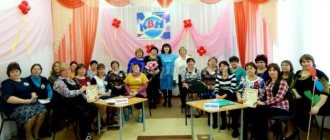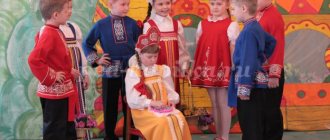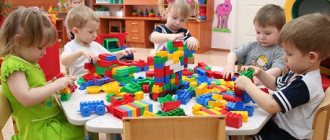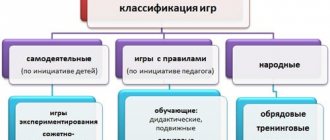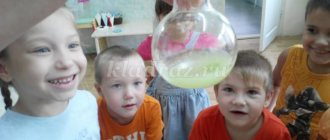Basic types of invigorating gymnastics and rules of conduct
Today, experts have invented many methods of invigorating gymnastics to awaken children. Among all this diversity, there are several that are most frequently used and effective. We are talking about verbal, visual, playful and practical exercises. Verbal awakening gymnastics consists of elements of logorhythmics, which are combined into one system of physical exercises to correct the child’s speech.
All movements must be accompanied by verses or phrases for the development of speech-motor and auditory analyzers. Also, during verbal gymnastics, breathing is regulated, motor skills are consolidated and the correct pronunciation of sounds is normalized. The first part of this exercise includes running and walking, and the second part includes movements that are accompanied by playful self-massages and poetry.
Methods of physical education
Note! As for visual gymnastics, it contains elements of corrective exercises. This type of exercise is designed to prevent the development of flat feet and eliminate postural disorders.
The main components are:
- exercises that form and strengthen the skills of correct posture;
- activities that form a stereotype and correct breathing.
The relative position of body parts is improved due to the respiratory muscles, so visual exercises are especially important.
Game gymnastics
A playful form of exercise helps children concentrate on performing exercises such as climbing over obstacles, running, jumping or catching a ball. The game is an indispensable tool that helps improve movement, coordination, speed, strength and endurance. During the game, memory, imagination and thinking are activated.
Important! Playful invigorating gymnastics should be accompanied by music, poetry or counting rhymes. Thus, children not only strengthen their physical fitness, but also expand their vocabulary.
Game exercises
Game exercises consist of introductory, main and final parts. The introductory part consists of easy running or various types of walking, as well as a game for concentration and exercises for the respiratory system. The main part includes a high level of mobility game, and the final part is designed to provide children with recreational activities and walking with breathing exercises.
Practical invigorating gymnastics
The practical form of training with children in most cases is represented by running, which is designed to regulate the load, strengthen the respiratory and cardiovascular systems, as well as coordinate the work of joints, muscles and ligaments.
Note! Running should be slow or moderate, during which the teacher needs to closely monitor each child so that he does not overdo the load, does not injure himself and rests in a timely manner.
The load must be increased gradually, taking into account the individual characteristics of each student and his physical fitness. For kids who have just entered kindergarten or have not attended classes for a long time, more than 50% load while running is contraindicated.
Methodology for conducting invigorating gymnastics: time plan and example notes
To maintain interest and maintain the child’s emotional state, you need to follow a clear time frame throughout the exercise. Exercises in bed immediately after waking up should last at least 2.5-3 minutes, the active block - 3-4 minutes, and breathing exercises - 2-3 minutes.
Active exercise in the garden
Note! Children should walk on massage mats for 1 minute. Tasks should be combined in such a way that the entire lesson lasts no more than 10 minutes.
The teacher's standard summary must indicate the educational area, location, explanatory note and objectives of the lesson. In the line “educational area” you need to enter physical development, in the “venue” - a playroom or bedroom of a kindergarten group. As for the main goals, the following are suitable:
- developing motivation to maintain and strengthen one’s health;
- eliminating drowsiness and lethargy in children through physical activity;
- formation of correct posture and prevention of the development of flat feet.
Also in the summary it is worth mentioning social-communicative, cognitive, speech and artistic-aesthetic development. Social-communicative involves nurturing friendly relationships between all students in the group, so that they learn to be mutually polite and make concessions. In the process of cognitive development, children consolidate their existing knowledge about the world around them and its components.
As for speech development, with its help the articulatory apparatus is prepared to pronounce sounds correctly, and the child’s vocabulary is also enriched.
Note! In the process of artistic and aesthetic development, the baby develops an interest in art, music and a sense of rhythm.
Also in the notes you need to write down the type of activity (game, communicative, motor or cognitive) and equipment that may be needed during the gymnastics class. You can use ribbed tracks, colored sheets, gymnastic hoops or massage balls.
Holding a wake-up call depending on the time of year and month
Wake up involves waking up children to calm melodious music, after which the kids must perform several physical exercises right in bed. Depending on what time of year it is outside, the melody can be different: quiet and classic if it is raining or snowing in winter, catchy and cheerful if the weather is sunny and warm outside.
The process of waking up children
Children should wake up and turn in different directions to the beat of the music, stroke their legs, spread their arms, clench and unclench their hands, and bend their knees. Everything is done strictly one by one, after which all children must stand on the massage carpet and perform several breathing exercises.
Gymnastics after waking up helps the child concentrate on subsequent lessons, strengthens children's physical health and improves their mood. It is for these reasons that the teacher should work with his pupils regularly, alternating games among themselves so that the children do not get tired of them.
Admission of children
This is where the outline of routine moments begins. With children of the older group, the teacher works to solve the following problems:
- Obtaining information about the health status of pupils.
- Creating a good mood.
- Strengthening hygiene skills in children, including a neat appearance and neatness.
- Formation of polite behavior towards peers and adults.
Older preschoolers usually happily run into the group and share news with their friends. Particular attention should be paid to new students, as well as shy children. If the child is in a bad mood, the teacher should distract him with an interesting activity, a work assignment (watering flowers, wiping leaves).
In the summer, pupils meet outside. Children can be offered games with soap bubbles and pinwheels. At this age, it is recommended to conduct psycho-gymnastics, when children stand in a circle, enjoy the morning together, smile at each other, and say kind words.
Card index
The preparatory course of exercises must be carried out in the form of a game.
In the first year of a baby’s life, you should not do without gymnastics. Exercises for speech and fine motor skills are suitable. It is important that the child understands the plot of the lessons so that he does not find it boring to do the exercises. For this purpose, there is a gymnastics card index on the Internet. Such card files contain sets of exercises that will be interesting for every child to do. Exercises are selected for children of any age. Parents can make lesson notes. You can also pick up a video. A special website will help with this (optionally, YouTube).
There are also books on children's gymnastics, which are suitable for children 2-3, 3-4 years old and older.
How much time does a child need to sleep?
Sleep is a special physiological state of our body. During sleep, physical strength is restored, important hormones are produced, and the brain absorbs all the information received during the day.
Each age has its own daily sleep norm:
- babies under one year old need to sleep from 12 to 17 hours a day;
- Children from one to three years old are recommended to devote 11-14 hours to sleep;
- preschoolers (3-7 years old) should sleep 10-13 hours;
- schoolchildren (7-14 years old) need 9-11 hours of sleep per day;
- Teenagers (14-17 years old) should devote at least 8-10 hours to sleep.
The older the child, the fewer hours he needs to restore physical and mental strength.
But it is difficult for children to understand the importance and necessity of this process. Therefore, in the evening they try to delay going to bed as long as possible, and most often simply ignore daytime rest.
How to put a child to sleep correctly: tips for parents
In order for a child to get up in the morning cheerful, rested and full of strength, it is necessary that he rest properly at night.
As a rule, children are reluctant to go to bed, preferring to watch another cartoon or play another interesting game. Therefore, it is important for parents to know how to properly prepare their baby for bed:
- Try to put your son or daughter to bed at the same time, focusing on the daily sleep requirement. For example, if you need to get your preschooler up at 7 o’clock, then he should go to bed no later than 9 o’clock in the evening. Children under 8-9 years old are recommended to be laid down by one of the parents. The child can go to bed himself; you just need to tuck in the blanket or say good night.
- If you have to change your routine due to moving or going to kindergarten, adjust your bedtime gradually over 2-3 months.
- On weekends, it is important not to disrupt the child’s sleep and wake schedule. A deviation of an hour and a half is allowed, but no more.
- Balance physical and mental stress throughout the day. If a child spends the whole evening doing homework after school, he needs a walk or a little physical activity before going to bed.
- A few hours before bedtime, eliminate all noisy games and the use of gadgets. Set your child up for a “calm wave”. A relaxing bath, a light massage or a good fairy tale can help you with this. It's good if this becomes your little ritual before going to bed.
- Try not to scold or punish your child before bedtime.
- Also an important factor for a child to fall asleep peacefully is the general daily routine in the family. It is not necessary to go to bed at the same time with your son or daughter. It is enough to turn off the TV, dim the lights in the rooms and eliminate loud conversations.
- A soft toy will help your baby fall asleep faster and not be afraid of the dark.
- A goodnight hug or kiss creates a feeling of security, which promotes good sleep.
- Teach your child to get ready for tomorrow in the evening. Prepare your clothes, pack your backpack, learn your homework. This way he will have the opportunity to sleep longer in the morning and not fuss around trying to get everything done.
By following these simple rules, you will teach your child to have proper rest after a busy day.
10 conditions for comfortable sleep
- Going to bed at the same time.
- The air temperature in the bedroom is not higher than 20 degrees.
- Humidity within 60%.
- Dinner 1.5-2 hours before bedtime.
- Soft sleeping clothes that allow the skin to breathe.
- Fresh bed linen made from natural fabrics.
- A night light with dim light if the child is afraid to fall asleep in the dark.
- Comfortable, spacious and safe bed.
- No loud sounds or extraneous noise.
- Bedtime ritual (fairy tale, relaxing bath, warm shower or massage).
Daily routine at preschool educational institution
One of the main tasks of the kindergarten is to satisfy all the needs of the body of preschool children, strengthen their health, and also develop useful cultural and hygienic skills. When compiling a summary of routine moments in the senior group, you can rely on the following table.
| Activity | Time frame (according to the “Origins” program) |
| Reception of children, their examination, free games | 7.00 — 8.20 |
| Charger | 8.20 — 8.30 |
| Breakfast | 8.30 — 9.00 |
| Educational activities along with preparation and breaks | 9.00 — 10.30 |
| Walk | 10.30 — 12.20 |
| Returning to the group, undressing | 12.20 — 12.35 |
| Dinner | 12.35 — 13.00 |
| Quiet hour | 13.00 — 15.00 |
| Lifting and hardening | 15.00 — 15.30 |
| Afternoon snack | 15.30 — 15.50 |
| Free games | 15.50 — 17.00 |
| Walk, children go home | 17.00 — 19.00 |
The teacher should encourage the activity and independence of pupils, organizing their activities at scheduled moments. In the older group, children already know how to wash and dress, and eat food carefully. It is necessary to consolidate the achieved results, and also gradually complicate the tasks.


